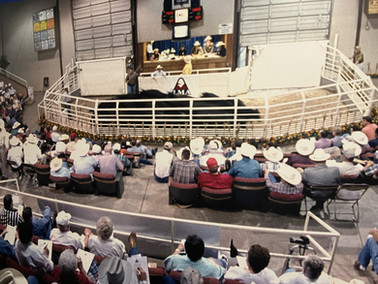Publisher’s note: If you enjoy reading these types of articles, please consider being a sponsor. Call Rob Doherty for more details: 417-334-9100.
Long before the Chiefs and Royals put Kansas City on the U.S. sports map, the city was known for something else—their stockyards.
Old friend, John Dillingham, the son of longtime president of the Kansas City Stockyards, Jay Dillingham, sat down with me and discussed the importance of the “yard” in the development of the city.
“If it wasn’t for the stockyards, I’m not sure we would even have a Kansas City,” John states from his Livestock and Exchange Building office in the same space where his father called the shots. “And if it wasn’t for the Texas tick, I’m not sure we would have a stockyards.”
After the Civil War, Texas longhorns were plentiful, but getting the beef to market was an epic lesson in perseverance; think of John Wayne’s classic western “Red River.”
Traveling straight east from Texas with a herd, cattle were confiscated without pay by occupying Union troops.
Seeking a safe and profitable way to get herds to the slaughter houses, Texans wanted to drive the cattle through Missouri to new plants on rail in Kansas City, but many arriving animals were infected with the Texas tick. The tick could and would be passed on to Missouri livestock and people.
The problem became so acute the governor of Missouri ordered troops to control and patrol the Arkansas/Missouri border keeping all longhorns out.
Another path to market had to be found.
The Chisholm Trail connecting southern Texas to Abilene, Kansas, where in 1867 the Kansas Pacific Railroad terminated was the 1,000-mile answer. Driving the herds to Abilene, the longhorns could then be transported east, with or without ticks to the quarantine pens in Kansas City, Kansas. After time and inspection, tick free cattle would cross the state line to the slaughter houses in the “west bottoms” of KC Missouri.
At one time there were 14 rail lines serving Kansas City. It was a hub for delivering beef products to the east and the rest of the world.
As the stockyards grew, so did Kansas City. It proudly became Cowtown USA with the largest livestock show and rodeo in the U.S., the American Royal starting in 1899.
Real estate developer J.C. Nichols told my father, “If it wasn’t for the Kansas City Stockyards, ‘the Plaza’ would have never been,” John recalls.
Other major events and accomplishments that advanced Kansas City’s growth was Order No. 11 issued by the Union Army in 1863, forcing Missouri property owners, without recourse, to abandon their land in Jackson, Cass, Bates and Vernon Counties after Quantrill’s murderous raid on Lawrence, Kansas. The Army designated Kansas City as an “acceptable” destination; settlers found refuge, doubling the city's population.
An accomplishment that added to the city’s growth was being chosen as the first place in the region to have a span over the Missouri River. The Hannibal Bridge opened in 1869, changing the game for people’s transportation westward, commerce, and advancing the importance of the city.
In the 1860 census, St. Joseph had four times the population of Kansas City, but I think politics came into play as to where the bridge would be built. St. Joe had seven companies with ferries and clout, making money carrying huge amounts of livestock, wagons and settlers across the river on their way west. The last thing they wanted was a bridge.
Kansas City survived and thrived after devastating floods. In 1883 and 1898, Missouri River waters consumed lowlands causing the city to rethink where it was located. Buildings in the “bottoms,” had to be rebuilt or moved. The railroad depot was destroyed and smartly reconstructed on higher ground where it majestically stands today. Union Station opened in 1914 just in time to serve as a transportation hub for throngs of soldiers ultimately headed to Europe serving our country in World War I.
In 1951 the worst flood in Kansas City history hit, reminding us all that Mother Nature was still in charge. With the West Bottoms, Argentine and SW Boulevard all decimated, we in river towns know floods “giveth and taketh away.”
The Kansas City Stockyards and Exchange Building had water in it three-feet deep...on the second floor! Imagine the stench of a flooded stockyards with stagnant water, fuel oil, animal waste and livestock carcasses rotting for weeks in the summer sun.
Federal help was needed to make sure this disaster never happened again.
As fate would have it, Independence’s Harry S. Truman was President with Abilene’s World War II Commander, Dwight D. Eisenhower, standing in the wings. Money became available for the Tuttle Creek Reservoir north of Manhattan, Kansas; Warsaw, Missouri’s Truman Dam; and for local levees to be built upstream trying to control the mighty Missouri.
Agriculture has always been Missouri’s and Kansas’ largest industry but a byproduct of the flood was the construction of those dams and reservoirs, helping develop the second largest industry in both state - recreation and tourism. A catastrophe like the ‘51 flood leading to enhancing business in both states is ironic to say the least.
Kansas City has grown into an important major city. Shaking its early Cowtown image with historic businesses and sites such as TWA, Hallmark Cards, the Plaza, a major rail hub, world class museums and champion sports teams.
So, the next time you are in the mood for a steak, think of the hardships and evolution of the city and the packing industry. To know someone like John Dillingham who witnessed much of the stockyards’ history is rare. Well, perhaps not. Maybe knowing him is just medium-rare.
————————————-
You can find more of Bob’s work including his Bob Ford’s History, Mystery and Lore podcast on his website, bobfordshistory.com. The podcasts are also available on most streaming services. YouTube videos are also available at Bob Ford’s History.



















Comments